Read Reviews
The Best Weed Killers
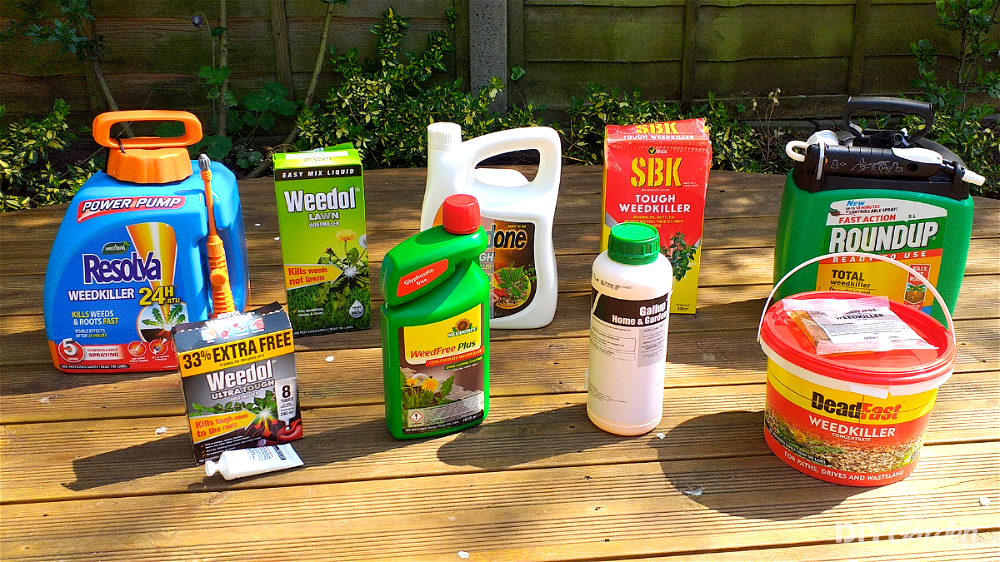
-
Best weed killer overall - Roundup Fast Action Weed Killer
-
Best commercial weed killer - Gallup Home & Garden Weed Control
-
Best for easy application - Weedol Ultra Tough WeedKiller Liquid Concentrate
-
Best weed killer for grass - Weedol Liquid Lawn Weed Killer
-
Best weed killer for block paving - Resolva 24h Power Pump Weed Killer
-
Best for driveways & patios - Job Done Tough Weedkiller
-
Best weed killer for brambles - Vitax SBK Brushwood Weed Killer
-
Most eco friendly - Neudorff WeedFree Plus Weed Killer
-
Best for killing roots - Rootblast Super Concentrated Weed Killer
-
Best pet friendly weed killer - Deadfast Concentrated Weed Killer Sachets
Weed Killer Reviews
1. Roundup Fast Action Weed Killer[ SAVE 40% ]
Best weed killer overall
- Results can be visible within 24 hours (although sometimes it can take a week)
- Jet spray is capable of reaching around 120 cm which keeps product away from hands and can target specific weeds
- Combination of hose, spray nozzle and jet mean it's not necessary to bend or stoop to apply product
- Strong enough to work on ragwort and moss
- Good option for tackling annual and perennial weeds
- Can stain patios and driveways if used on or near to them
- Pump needs to be primed around 25 times for a steady flow which can be hard work
- 5 L container must be carried around which may get heavy for some people
- Contains Glyphosate which can harm wildlife and should also not be used near food crops
- Visible Results
- 1 - 2 days
- Application
- Pressure sprayer
- Capacity
- 5 L
- Treatment Area
- 150 m²
- Kills The Root?
- Yes
- For Lawns?
- No
- Speed of Results
- 4.8
- Longevity
- 4.6
- Value for Money
- 4.7
Getting rid of weeds can be a long, slow process, but it can be made a lot quicker by using Roundup Fast Action Weed Killer. This is the best weed killer overall – it’s powerful and also simple to apply.
There are a couple of reasons why this pump spray weed killer speeds up the process of getting rid of pesky weeds, and it comes down to both its effectiveness, and its straight-forward application style.
Whilst some other weed killers require dilution, like the Weedol and SBK options featured on this page, this Roundup Weed Killer gets sprayed straight from the bottle. The large 5 L container comes with a hose and nozzle already attached, so you just carry it around whilst targeting weeds.
The weed killer is straight forward to apply, and there’s a built-in pump pressure sprayer which helps spread the liquid. When sufficiently pumped, the pressure sprayer bottle projects the weed killer to around 120 cm, keeping the product away from your hands.
The nozzle can be twisted to select either a ‘jet’ or a mist; however, the mist is not particularly fine. The jet, on the other hand, can be used as expected to sufficiently target individual weeds.
When it comes to product effectiveness, Roundup Weed Killer is pretty powerful. Moss, weeds, grass and flowers can all fall victim to this herbicide. It’s a good choice for tackling perrenial weeds. However, occasionally, the odd weed may be impervious to its effects.
It can take anywhere for 24 hours to one week to see weeds start to die, and some may require a second application. It’s also not a residual weed killer which is good news – it becomes inactive on contact with soil and is broken down by micro organisms in the soil to allow for replanting.
Overall, Roundup is a well-known name in the world of weed killers, and under certain conditions it can completely clear large patches of heavy-duty weeds. It’s best used in dry spells, so that rain can’t wash it away before it’s had a chance to work, and should be used with care around wildlife, pets and children due to its Glyphosate content.
Did you find this review helpful?
2. Gallup Home & Garden Weed Control
Best commercial weed killer
- Exceptionally strong - kills roots within 2 weeks
- Visible results within 24 hours
- Works a lot faster than other weed killers on the market
- Liquid sprays easily onto weeds
- Safety instructions are difficult to access - need to peel the upper label back
- Doesn’t come with a measuring cap so you’ll need to use your own
- Not safe for pollinators although it is broken down into the soil
- Visible Results
- 1 day
- Application
- Sprayer / watering can
- Capacity
- 2L
- Treatment Area
- 3332m²
- Kills The Root?
- No
- Speed of Results
- 5
- Longevity
- 4.5
- Value for Money
- 4.5
The Gallup Home & Garden Weed Control has been promoted as the strongest weed killer available for domestic use, and it did work very well. I noticed visible results within 24 hours, and the roots were killed within a couple of weeks. It’s been designed for both annual and deep-rooted perennial weeds.
This weed control is exceptionally strong, with a single 2 L bottle treating up to 3332 sqm. It would be ideal for those with a badly overgrown allotment or garden, but it’s also a good choice if you’re after a super strong weed killer for deep-rooted weeds.
This product requires diluting, so a lot of care needs to be taken not to get the product on your skin. It doesn’t come with a measuring cap included, so you will need to purchase one separately in order to accurately dilute it. The liquid can then be applied using a sprayer, covering up to 40 sqm.
This weed killer is very effective, destroying weeds at the roots within 2 weeks. The smell alone is enough to indicate that it’s exceptionally powerful, so while it is very effective, a lot of care needs to be taken during use. It worked on all the weeds I treated it with.
It does contain glyphosate, which is toxic to ponds and pollinators. It’s broken down into the soil so isn’t bad for the environment in that sense, but you do need to be careful to keep children and pets off the affected area until it’s dried.
One final thing to note is that the safety instructions are difficult to access. The top label needs to be peeled back to reveal the safety instructions, which for such a toxic product, really should be easier to spot!
Overall, this weed control solution is incredibly strong and effective, but you do need to handle it with a lot of care.
Did you find this review helpful?
3. Weedol Ultra Tough WeedKiller Liquid Concentrate
Best for easy application
- Can be applied using either a sprayer or watering can
- Liquid sprays easily and it’s easy to cover all the weeds
- Kills weeds at the roots
- Dries in around 15 minutes
- Comes with 8 small tubes individually packaged
- If it rains within 6 hours of application, the treatment will need reapplying
- Some weeds may require reapplication
- The key ingredient is glyphosate which poisons pollinators
- Visible Results
- 1 day
- Application
- Sprayer / watering can
- Capacity
- 5L
- Treatment Area
- 240m²
- Kills The Root?
- Yes
- For Lawns?
- No
- Speed of Results
- 4.5
- Longevity
- 4.5
- Value for Money
- 5
The Weedol Ultra Tough WeedKiller Liquid Concentrate is arguably the easiest weed killer to apply of all the ones I tested. It doesn’t come pre-mixed, but it can be diluted in either a watering can or sprayer.
There’s no mess or measuring required, because this product comes in 8 individually packaged tubes. The entire tube can be squeezed into your watering can, topped up with 5 L of water. If you’re going to be using a sprayer, you’ll need just 1 L of water. Then simply mix and you’re ready to go!
This weed killer works very well, killing most weeds fairly quickly. It worked especially well to remove dock leaves, while the oxalis also turned crisp. It removes weeds at the roots, and you should see an effect within 5 days. After a week, it was clear the weeds were beginning to die off, and after 3 weeks, the roots were pretty much all dead.
While it takes longer than others on the market to see results, the results even so were impressive. Some weeds may require reapplication, but you shouldn’t find this weed killer lets you down in any way. The fact that it’s individually packaged means you can be sure that you’re applying the right amount.
Another benefit is that it dries very quickly. While children and pets need to be kept off the treated area until it’s dried, this took around 15 minutes. One thing to note is that you do need a dry day to apply this product – as if it rains within 6 hours of application, you’ll need to reapply.
Like many off-the-shelf weed killers, it contains glyphosate. While this is strong enough to kill weeds, it’s also strong enough to harm pollinators and pond life. Having said that, treated areas can be replanted 7 days after application, which isn’t bad going for a weed killer.
All in all, this weed killer is ideal for those who value ease of application. The individual packaging, while not great for the environment, certainly makes it easier to use this Weedol product.
Did you find this review helpful?
4. Weedol Liquid Lawn Weed Killer[ SAVE 11% ]
Best weed killer for grass
- Can clear lawns of clover and dandelions without damaging the grass
- Good value for money, coming as a concentrated liquid that can cover a large area
- Simple to dilute with water and apply using a watering can or sprayer
- Weeds can be seen to start dying in approximately one week
- Only recommended for use once per year which may not be enough for tough weeds
- Won’t kill moss so a separate moss killer may be required
- Requires diluting, making it a slower process to apply than ready-to-go weed killers
- Contains chemicals that can be harmful to wildlife
- Relatively slow acting, taking anywhere from one week to one month to fully kill weeds
- Visible Results
- 7 days
- Application
- Sprayer/watering can
- Capacity
- 1 L
- Treatment Area
- 667 m²
- Kills The Root?
- No
- For Lawns?
- Yes
- Speed of Results
- 4.5
- Longevity
- 4.8
- Value for Money
- 4.4
A lot of products kill grass as well as weeds; however, there are a few weed-killer gems worth knowing about if you’re keen to clear your lawn without damaging it. This Weedol Lawn Weed Killer is successful at removing clover, dandelions and other unwanted culprits from lawns, without scorching or killing off the grass.
This makes it one of the best selective weed killers, making it possible to carry out targeted weed killing on the lawn!
It’s also one of the best products in terms of value for money, coming in a liquid concentrate that can be diluted to cover up to 667 m².
As a result, slightly more preparation is required than with ready-to-go weed killers. You’ll need to mix 15 ml of Weedol weed killer with 1 L of water in a watering can with a fine rose before applying it to the lawn.
However, the results are reliably positive, albeit slow – it takes around one week for clover to start visibly yellowing and dying. There may still be the occasional dandelion that needs to be removed by hand after using Weedol Weed Killer, but it does a fairly comprehensive job of clearing the lawn (without harming the lawn itself).
One disadvantage of using this weed killer is that you have to be careful with disposing of your grass clippings. Because of the chemicals used, grass clippings should not be disposed of in the standard council-collected green waste. If you choose to compost them , they need to be composted for at least 9 months before being suitable to use as mulch on the garden.
If you’re after a way to get rid of a lot of weeds on your lawn, without damaging the grass, Weedol Weed Killer is one of the best safe-for-lawn weed killers.
However, as with all chemical weed killers, it could have a negative effect on wildlife, and children and pets should be kept away from the treated area, so just because it doesn’t kill grass don’t be fooled into thinking the chemicals are less hazardous.
Did you find this review helpful?
5. Resolva 24h Power Pump Weed Killer[ SAVE 22% ]
Best weed killer for block paving
- Can tackle tough weeds like dandelions and stop them from coming back
- Weeds often don't return, even four weeks later
- Container is refillable, saving on the necessity to keep buying large plastic bottles
- After approximately one week weeds can be dry enough to pull up
- Pumps out liquid at a good rate that is neither wasteful nor too slow
- Best used on a dry, sunny day and shouldn't be used if rain is forecast on the same day
- Often takes longer than the advertised 24 hours to work; a more accurate timeframe is 4 - 7 days
- Will kill grass if used on patches of weeds on the lawn
- Contains Glyphosate which can be harmful to wildlife and should not be used near food crops
- Visible Results
- 1 day
- Application
- Sprayer
- Capacity
- 5 L
- Treatment Area
- 18.5 m²
- Kills The Root?
- Yes
- For Lawns?
- No
- Speed of Results
- 4.7
- Longevity
- 4.5
- Value for Money
- 4.5
Not all weed killers successfully target the roots of weeds, which can result in them growing back. However, this Resolva 24h Weed Killer gets down into the roots of even well-established perennial weeds, stopping them from returning. It’s the best weed killer for effectively killing weeds at the root.
It works well, successfully killing off tough perennial weeds like dandelions, and clearing larger weeded areas too, although the claims of ‘24-hour effectiveness’ are somewhat optimistic.
Whilst Resolva Weed Killer is powerful, it often takes several days to see results. Weeds are more likely to die after 4 – 7 days than 24 hours. However, after a week, once they’re dead, they’re generally dry enough to simply pull out of the ground.
In terms of application, the container holds 5 L of liquid which is applied to weeds via a built-in spray nozzle. This makes it ideal for block paving.
Pumping the handle creates pressure in the container, and when the button on the wand is pressed, the weed killer travels through the hose and out of the nozzle. The output can be adjusted, producing either a spray or a fine jet.
It seems to work best in hot, dry weather, and certainly shouldn’t be applied when rain is forecast for the same day; the longer the weed killer stays on the weeds, the more effective it will be.
The general consensus seems to be that once weeds are gone, they don’t come back, making this the best weed killer for getting to the root of the problem (!) and getting rid of even deep rooted weeds. This is therefore an excellent choice for tackling perennial weeds. It just might take a little while to work, and possibly require more than one application.
Did you find this review helpful?
6. Job Done Tough Weedkiller[ SAVE 6% ]
Best for driveways & patios
- Results are visible very quickly - within a couple of hours
- Included sprayer has two functions, a jet and a fine spray, so you can either spot clean or cover a larger area
- Arrives ready-mix so there’s nothing to do before application
- Gloves are essential as the weedkiller gets over the nozzle, and this nozzle needs to be adjusted by hand
- Each pump sprays just a small amount of weed killer, so you need to work quite hard to cover a large area
- Kills all greenery including grass, so a lot of care needs to be taken
- Visible Results
- 1 day
- Application
- Sprayer
- Capacity
- 3L
- Treatment Area
- 50m²
- Kills The Root?
- Yes
- For Lawns?
- No
- Speed of Results
- 5
- Longevity
- 4
- Value for Money
- 4.5
For fast results, the Job Done Tough Weedkiller is one of the best. This worked a good deal better than household name weed killers. It has a helpful internal sprayer that allows you to tackle individual weeds including dock and couch grass.
One of the best things about this weed killer is that it’s fairly simple to apply. There’s a ‘flexi spray’ that clips out of the body, with the pipe clipping to the lid. There’s two spray functions, a jet spray and a fine spray. You will need to touch the nozzle, so gloves are required.
The only negative when it comes to application is that it takes a few pumps to get a decent amount of weed killer out. You’ll need to get fairly close to the weeds to cover them, and those with weaker hands or reduced mobility may find they’re working harder than is comfortable for them.
This weed killer can kill all greenery (including your lawn!) so a lot of care needs to be taken. If you spray any weeds on your lawn, you’ll likely affect the surrounding area too. For this reason, it’s better for individuals or clusters of weeds on your driveway or patio.
It does work well however. Weeds are visibly sick within a couple of hours and the roots killed off within a couple of weeks. Dock leaves however, did need a second application.
One downside of this weed killer is that it makes the soil unusable for a period of time. This is fairly disappointing if you’re wanting to get planting. The instructions state that it takes a ‘growing season’ to wear off, meaning potentially an entire spring or summer!
For this reason, this weed killer is best used on driveways and patios, as opposed to within flower beds. That said, it does work very well and should keep these weeds at bay for up to 3 months.
Did you find this review helpful?
7. Vitax SBK Brushwood Weed Killer[ SAVE 11% ]
Best weed killer for brambles
- Can kill brambles and soften tree stumps to make them easier to remove
- Offers good value for money as it comes as a concentrated liquid
- A good choice for completely overgrown, unruly gardens
- Can be applied using either a watering can or weed sprayer
- May require several applications to see desired effect
- Results are slow and aren't always visible until around three weeks after application
- Concentrated solution needs to be carefully diluted before use which takes time
- Weeds often need to be cut back to stumps before application
- Visible Results
- 1 - 2 days
- Application
- Sprayer/watering can
- Capacity
- 1 L
- Treatment Area
- 332 m²
- Kills The Root?
- Yes
- For Lawns?
- No
- Speed of Results
- 4.5
- Longevity
- 4.5
- Value for Money
- 4.5
If your weed problem is bigger than just dandelions and clovers, this Vitax SBK Brushwood Tough Weed Killer is a bit more heavy duty. It can see off hardier plants like brambles, nettles and thistles, and is the best weed killer for clearing overgrown, unruly spaces.
Some preparation is required first, of both the weed killer and the overgrown area. It’s not as simple as just throwing SBK over an overgrown plot. For best results, use a brushcutter to cut reduce the overgrown plants back to their stumps before using this weed killer.
It comes as a concentrated liquid, so you need to dilute the weed killer before applying it to the garden. This is done by adding 30 ml of weed killer into 6 L of water (if using a watering can and a fine rose). This produces enough weed killer solution to treat an area of 10 m².
As well as tough, woody weeds, SBK is also capable of getting rid of tree stumps; a diluted solution needs to be poured into drilled holes in the wood which turns the stump soft and mushy after about a month.
Whilst not a particularly fast-acting weed killer, compared to those which show results in a couple of days, results on weeds should start to be visible after a couple of weeks. Although it’s one of the strongest weed killers, it may take a few weeks to notice brambles dying off. A repeat application after six weeks might be required.
Overall, this is certainly one of the best weed killers for getting rid of tougher weeds and tree stumps, but it does need to be used with patience as the results aren’t instant. Also, it offers quite good value for the price, with the 1 L bottle containing enough formula to cover up to 332 m² when diluted.
If you’re looking for the strongest weed killer, this SBK is a great option to consider. It’s useful for tackling areas of dense growth and permanently removing weeds without too much physical exertion. It’s also the best weed killer if you want a versatile product that can be used on tree stumps as well!
Did you find this review helpful?
8. Neudorff WeedFree Plus Weed Killer[ SAVE 9% ]
Most eco friendly
- Effective at killing horsetail and other problematic weeds
- Can cause leaves of common weeds to wilt within a few hours
- Product does not remain in the soil which means reseeding and planting can be done soon after treatment
- Does not contain glyphosate and is considered more environmentally friendly than products that do
- Can be applied to body of specific weeds meaning that no other plants are touched by the product accidentally
- Weeds may grow again in the same area if seeds were left behind because treatment doesn't stay in soil
- Not effective if it rains shortly after application
- A couple of applications may be required before all weeds are killed
- Visible Results
- 1 day
- Application
- Sprayer
- Capacity
- 1.02 L
- Treatment Area
- 60 m²
- Kills The Root?
- Yes
- For Lawns?
- No
- Speed of Results
- 4.5
- Longevity
- 4.4
- Value for Money
- 4.4
Whilst Neudorff might not be a particularly well-known company, their WeedFree Plus Concentrate is a powerful weed killer that works on relatively stubborn weeds.
Whilst not all products can successfully get rid of pervasive weeds like horsetail, this WeedFree Plus weed killer causes it to turn brown in a couple of days. Other, more common weeds, can show signs of wilting within a couple of hours.
The weed killer needs to be diluted. Then, the diluted product can be sprayed or applied directly to the stem of the weeds. This makes it possible to avoid getting weed killer on other plants.
Also, it’s worth noting, that whilst WeedFree Plus does seem to attack weeds down to their roots, it does not remain in the soil (unlike residual weed killers). This means that perennial weeds may grow again in the same place.
On the plus side, the fact that this product isn’t left in the ground means that the treated areas can be sown or planted again relatively soon after using the product.
The bottle of weed killer automatically dispenses out pre-measured amounts of the concentrated product. Although some thought is still required whilst making up the diluted formula, it’s easier than a classic free-pour dispenser.
This weed killer also doesn’t contain glyphosate, using a combination of pelargonic acid and maleic acid hydrazide instead. These attack the leaves and roots of the weed. These chemicals are generally considered to be safer to use around food crops.
WeedFree Plus Concentrate is quite an easy-to-use weed killer which can see some weeds wilting in a few hours after application. It can also take on tougher, pervasive weeds like horsetail, so it’s one of the best weed killers for tackling tough plants without using glyphosate.
Did you find this review helpful?
9. Rootblast Super Concentrated Weed Killer
Best for killing roots
- Easy to measure using the included measuring cap
- Does kill most weeds including docks, nettles, dandelion and bindweed
- Can be used to kill tree stumps
- Results are slightly slower than others on the market
- Needs to be applied at a higher dose for quicker results
- Needs to be left to dry for up to 48 hours before pets are allowed back onto the treated area
- Visible Results
- 7 days
- Application
- Sprayer / watering can
- Capacity
- 1L
- Treatment Area
- 1666m²
- Kills The Root?
- Yes
- For Lawns?
- No
- Speed of Results
- 4
- Longevity
- 4.5
- Value for Money
- 4.5
With a name like ‘Rootblast’, you’d expect the Rootblast Super Concentrated Weed Killer to do more than just kill the leaves. Indeed, it did a very good job getting down to the roots of the weeds I treated with it, including docks, nettles, dandelions and bindweed. It can also be used to kill tree stumps, although I wasn’t able to test this.
This bottle contains 360 g of product, enough to cover a 1666 sqm area. It does require mixing before application, but it comes with a measuring cap included which is very easy to use. It can be applied using either a watering can or a sprayer.
In terms of results, this weed killer certainly delivered. It produces results within 7 days, but the weeds won’t be killed at the roots for a lot longer. If you’re wanting a fast acting weed killer however, you may prefer another product listed on this page. Alternatively, you could apply it at a more concentrated rate for faster results.
With glyphosate as its primary ingredient, this product does need to be handled and used with care. It’s toxic to pollinators and pond life, and children / pets need to be kept off the treated area until it’s dried. It does take a while to dry – up to 48 hours.
Once the weeds have died off, you can replant in the soil.
Overall, this weed killer is a good choice if you’re after long-term as opposed to fast results. It’s very good value for money, while mixing the correct amount is fairly easy. Its only downside is the long drying time, but this isn’t too much of an issue.
Did you find this review helpful?
10. Deadfast Concentrated Weed Killer Sachets
Best pet friendly weed killer
- Easy to mix the solution as it comes in handy liquid sachets
- Does kill most weeds and gets down to the roots
- Weeds start to wilt within a day so you can see that it’s working
- t’s easy to squeeze the product onto your fingers so gloves are essential
- Results are slower than they are with other weed killers, around 3 - 4 weeks for the roots to be killed
- Contains glyphosate which is toxic to bees and pond life
- Visible Results
- 7 days
- Application
- Sprayer / watering can
- Capacity
- 1.2L
- Treatment Area
- 720m²
- Kills The Root?
- Yes
- For Lawns?
- No
- Speed of Results
- 3.5
- Longevity
- 4
- Value for Money
- 4
The Deadfast Concentrated Weed Killer Sachets is for those who don’t want to worry about mixing the right amount of product. It comes with 12 sachets and is able to cover up to 720 sqm. You can simply dispense a sachet of product into a watering can, add water and then apply to the weeds you are wanting to treat.
This weed killer can be applied using either a spray or watering can. Or, for more stubborn weeds, it can be applied directly from the packet onto the roots. Of course, applying this way will give you less value for money, but for very deep-rooted weeds, it does work well.
One thing to note about this weed killer is that it doesn’t work especially fast. To kill the roots, it needs around 3-4 weeks. While the weeds do start to wilt within a few hours, it takes 7 days before I actually felt the weed killer was working! Despite the slower results, it does work as well as others on the market, and it’s very easy to use.
Like most weed killers I’ve tested, this product does contain glyphosate which isn’t wildlife friendly. Flower heads should be cut off weeds first, especially dandelions.
Once the product has dried, children and pets can use the treated area. It can take a few hours for the product to dry, so your garden may be out of action for this time.
Another thing to mention is that as the product arrives in individual packets, which isn’t particularly good for the environment. If you want to use as little packaging as possible, you may prefer a different product.
All in all, this weed killer is a decent option, but gloves are essential as it’s fairly easy to squeeze some of the product onto your fingers. If you value ease of mixing over fast results, this may be a good choice.
Did you find this review helpful?
Product Tester
I tested various weed killers to identify the best of the best, so you don’t have to. I was looking for the most effective and eco-friendly weed killer, so I conducted a comprehensive test assessing the following factors:
- Speed of Results: Ideally, I was looking for fast-acting products that showed results within 24 hours. Any product that achieved this was rated higher. If the product also killed the roots within a 2-week window, this was also deemed highly effective. I marked down any weed killers that took 7 days to show the first signs of success, and those that took even longer received the lowest rating.
- Longevity: Any weed killers that needed to be reapplied after rain were significantly marked down, as this doubled the time you’d have to spend on weed killing. Weed killers that killed the entire plant, including the roots, were rated the best, as these are the only products that ensure long-lasting results.
- Safety and Environmental Impact: It was important to assess the overall environmental impact of each weed killer as well as the risk to the user’s safety. As a result, any product where the nozzle leaked was rated lower, as this risked harm to the gardener using it. Products with excessively harmful chemicals, such as Glyphosate, were marked down, as these pose a risk to wildlife.
- Ease of Application: When reviewing ease of application, I deemed any weed killer that came ready-mixed better for the average gardener, as less time will be spent preparing the solution. I also looked for products that came with different attachments – such as a nozzle and hose – to make application easier. Models with additional features, such as a built-in pressure pump and adjustable nozzle settings, were rated highest, as these elements made the product easier to use.
- Value for Money: When assessing value for money, I identified how many litres of weed killer you received, the treatment area it covers, and the price point. Products that covered a higher surface area and still retained their effectiveness (for example, a 2 L bottle able to cover over 3000 sqm) were rated higher than those that only covered a smaller surface area for the same – or similar – price. I also assessed the additional features that come with a weed killer, as these products give you better value for money.
Compare Product Features
Use the dropdown to sort the table by the feature you want to see.
Roundup Fast Action Weed Killer
- 4.7
- 1 - 2 days
- Pressure sprayer
- 5 L
- 150 m²
- Yes
- No
Gallup Home & Garden Weed Control
- 4.7
- 1 day
- Sprayer / watering can
- 2L
- 3332m²
- No
Weedol Ultra Tough WeedKiller Liquid Concentrate
- 4.7
- 1 day
- Sprayer / watering can
- 5L
- 240m²
- Yes
- No
Weedol Liquid Lawn Weed Killer
- 4.6
- 7 days
- Sprayer/watering can
- 1 L
- 667 m²
- No
- Yes
Resolva 24h Power Pump Weed Killer
- 4.6
- 1 day
- Sprayer
- 5 L
- 18.5 m²
- Yes
- No
Job Done Tough Weedkiller
- 4.5
- 1 day
- Sprayer
- 3L
- 50m²
- Yes
- No
Vitax SBK Brushwood Weed Killer
- 4.5
- 1 - 2 days
- Sprayer/watering can
- 1 L
- 332 m²
- Yes
- No
Neudorff WeedFree Plus Weed Killer
- 4.4
- 1 day
- Sprayer
- 1.02 L
- 60 m²
- Yes
- No
Rootblast Super Concentrated Weed Killer
- 4.3
- 7 days
- Sprayer / watering can
- 1L
- 1666m²
- Yes
- No
Deadfast Concentrated Weed Killer Sachets
- 3.8
- 7 days
- Sprayer / watering can
- 1.2L
- 720m²
- Yes
- No
How to Choose The Best Weed Killer
Ah dear, time to talk about every gardener’s worst nightmare…weeds!
I think we all agree that having the odd weed here and there is par for the course in the garden. However, those pesky plants can spread so rapidly, they easily have the potential to invade entire lawns and flowerbeds.
Forks, trowels and hoes are good to have in the armoury against stubborn weeds. But sometimes you need something more. An effective weed killer can help truly eliminate weeds, keeping your garden looking pristine. Plus, they’re not only useful in the battle against common weeds; certain weed killers can get rid of brambles, nettles and thistles as well.
READ NEXT: Where Do Weeds Come From?
The following information will help you work out how to find the best weed killer for your garden:
Different Varieties of Weed Killer
There are a range of weed killers on the market and they attack weeds in different ways:
- Selective weed killer is usually safe to use on lawns as it won’t kill off the grass. It will only target and kill specific types of plans (eg. weeds). Selective weed killer is normally clearly sold as being lawn safe. Therefore, if a weed killer doesn’t mention being safe for lawns, don’t use it on grass (unless you don’t mind the grass getting scorched).
- Non-selective weed killer will kill weeds and any other plant it comes in contact with. It needs to be applied with care to make sure they don’t get on any grass or prized plants by accident.
- Systemic weed killer has the strength to kill even resistant plants like brambles and briars. Systemic weed killer is applied directly to the plant and absorbed. It travels down to the root, killing the plant from the inside out. It generally works slower than other weed killers, but can be more powerful. It will effectively tackle deep rooted weeds.
- Residual weed killer is applied to the soil and prevent seeds from germinating. Whilst it stops weeds from growing, it also tends to stop any other plants from germinating as well. Residual weed killer is long lasting, remaining active in the ground for around 12 months.
- Natural weed killer is any weed killer made from natural ingredients. While these tend to be less effective than industrial strength weed killers, they are safer to use on your lawn and kinder to wildlife. More details can be found about the ingredients found in commercial natural weed killers in the “Ingredients in Weed Killers” section below.
- Some people also choose to use homemade natural weed killers, using a solution of white vinegar, salt and liquid dish soap.
READ NEXT: How to Stop Weeds Growing in Block Paving
How Weed Killers Work
Weed killers use herbicides to control, limit and stop plant growth.
The actual chemicals vary depending on the type and brand of weed killer, but they tend to work in a combination of the following ways:
- Stopping Photosynthesis. Plants need light in order to survive and create food, a process known as photosynthesis. Some weed killers work by stopping the plant’s ability to photosynthesise. This will starve the plant and effectively kill weeds.
- Stopping Protein Production. Protein production is another essential element of plant growth and health. Some weed killers stop plants from being able to produce proteins. Ultimately this will kill weeds. Glyphosate works this way; however, do your research before using products which contain Glyphosate – is has been shown to have negative effects on health.
- Introducing Different Hormones. The plant’s hormones dictate its growth. Some weed killers contain plant hormones that, when applied to the plant, confuse the plant’s growth system. This will kill weeds as the plant eventually becomes deformed and dies.
Ingredients in Weed Killers
Whilst there are a lot of ingredients that can go into weed killers, some are used more commonly than others.
The ingredients dictate what type of weed killer it is, and often a combination of ingredients are used.
Here we will look at the ingredients of weed killers, based on what type of weed killer they’re most commonly used in. There are selective weed killers (only targeting certain plans), non-selective weed killers (not fussy about what plants they kill) and organic weed killers (using ingredients from nature).
Be careful using weed killers around food plants. Many of them are unsafe for use around crops. There are some which are considered to be ok, but you should always do your own research on specific products and read the label carefully.
READ NEXT: How to Clear a Garden Full of Weeds
Ingredients Commonly Found in Selective Weed Killers
These ingredients are used because they specifically target certain types of plants. Therefore, they are often found in selective weed killers as they shouldn’t kill of grass or other vegetation that they’re not intended for.
Generally, a combination of these ingredients is used to make the weed killer more effective.
- Fluroxypyr – specifically targets plants like cleavers and other similarly broad-leafed weeds.
- Dicamba – effective against broadleaf weeds like milkweed, as well as woodier plants like brambles.
- Mecoprop-p – good at controlling knotweed and clover as well as other broadleaf weeds before they have reached maturity.
- Florasalum – effective against dandelions, white clover and daisies before the plants have reached maturity.
- Clopyralid – combats tougher weeds like thistles and clovers
- MCPA – stands for ‘2-methyl-4-chlorophenoxyacetic acid’ and is used to keep broadleaf weeds like thistle at bay.
Ingredients Commonly Found in Non-Selective Weed Killers
These ingredients are used because they will attack any type of plant. They may be used in different concentrations, with other ingredients as well.
- Glyphosate – kills the majority of plants, including perennial grasses, so it’s not one that you want to accidentally get on the lawn or flowerbed. It is effective at killing well-established weeds because it works from inside the weed itself. After being absorbed by the leaves and stalk of the weed, glyphosate spreads to the rest of the plant, including the roots. In recent years, it’s developed a reputation for being dangerous; however the jury is out on a definitive conclusion. Some studies have found it to be carcinogenic, whilst others consider it safe for humans to use as long as the instructions are followed. Glyphosate is also thought to negatively affect wildlife such as bees and aquatic life. It can stay in the soil for a long time as well.
- Flazasulfuron works on weeds when they first start growing, as well as when they are in their ‘adolescent’ stage. It’s absorbed by the roots and then works its way through the rest of the plant.
Ingredients Commonly Found in Organic Weed Killers
Weed killers with organic ingredients can still be strong, and contain harmful ingredients as well. However, organic ingredients are generally considered less damaging for the environment and wildlife.
- Pelargonic acid is the most commonly found active ingredient in organic weed killers. It’s a naturally occurring acid in geraniums. This acid is generally considered effective at controlling the growth of smaller broadleaf weeds (under 15 cm tall).
Organic weed killers are less likely to stay in the soil, and may be suitable for use near food crop plants. Also, you can often plant into the soil at soon as the weeds are gone, instead of having to wait for the chemicals to leave the soil. (again, check the label of the specific weed killer you’re using).
General Weed Prevention
After treating your garden with weed killer, you’ll have a clean slate. But how can you stop the vicious cycle of weeds growing back?
Well, prevention is the best cure and there are several tactics you can use to keep weeds away. You might prefer some methods over others, or consider using a combination:
- Prevent weed seeds from germinating by using a weed killer that stays in the soil. This will stop weeds from growing, but will also stop any other plants from germinating as well.
- Consider mulching. A thick layer of organic mulch can prevent weeds from taking over your garden. This will help the soil retain moisture while also suppressing small weeds.
- Use thick weed-control fabric/weed membrane. A weed-control fabric/weed membrane can prevent weeds from growing. It’s perfect to use under paths or decking. It allows water, nutrients and air to pass through, while stopping weeds growing. These are generally very easy to lay and offer a cost-effective way to prevent garden weeds. If you want more information about weed membranes and how they can help, check out this page on the best weed membranes.
- Don’t leave bare soil. Weeds thrive in open spaces in the soil. Plant vegetables, flowers and shrubs close together to minimise open areas where weeds can pop up.
- Fertilise grass regularly. This can prevent new weeds from growing on the lawn. Fertilising can help grass build a healthy root system which can choke out weeds, whilst improving the condition and look of your lawn at the same time.
When to Apply Weed Killer
It’s important to note that the chemicals in most weed killers are not as effective during warmer temperatures.
This is not necessarily due to any shortcoming of the herbicide itself, but related to how plants absorb moisture. Most plants absorb more moisture in the cool temperatures of the early morning, but stop when temperatures rise in the afternoon.
So, for the best results, apply your weed killer early in the day.
All weed killers have the potential to be washed into other areas through rainwater runoff.
Spraying during windy conditions can also cause the chemicals to spread to areas that you did not intend to treat, killing plants that you wanted to save.
Therefore, you should avoid using weed killer if you know it’s going to rain or if it’s windy.
Other Methods for Removing Weeds
Using a chemical weed killer may not be everyone’s first choice. Sometimes, it becomes the only option, especially if you are up against an overgrown garden of brambles, or persistent weeds that won’t stop coming back.
However, there are some other weed-removal options that you can consider, or that you might want to use alongside chemical weed killers:
- Some weeds can be killed by simply pouring hot water over them. This can be effective on patios and driveways but will scald grass if used on the lawn.
- Use a long-handled weeding tool, or a weeding knife. This makes weeding more a manual process, but there are some effective tools that make the job less backbreaking. You might like to check out this page on the best weeding tools to find out more.
- Purchase a weed burner to pinpoint certain weeds. These tools are designed to heat weeds and make their cells burst, causing them to die. They’re quite effective, and can stop bigger weeds like dandelions from growing back. If frazzling your weeds to death sounds like something you’d be interested in, you can check out our page on the best weed burners.
- Regularly hoe any loose soil to combat small weeds. This can be both a preventative and offensive measure; it discourages weeds from taking root as well as disrupting the growth of new weeds.
Getting rid of weeds without chemicals can be hard work, but it can be done.
Keeping informed about the growing habits of different weeds can help, as you can try to dissuade certain species from growing in your garden.
Weed Killer FAQs
Weed killer uses chemicals (herbicides) to control, limit and stop plant growth. The actual chemicals in the formulation can vary depending on the brand and the type of weed killer in question.
A ‘selective weed killer’ will contain ingredients that target certain types of weeds. These are often safe for use on grass as their ingredients won’t affect it.
A ‘non-selective weed killer’ will damage any plants that it comes into contact with. They’re generally more powerful than selective weed killers, but you need to be careful with their application and make sure they don’t get onto any plants you don’t want them to.
You should always read the packaging before applying weed killers on or near to to edible plants that you intend to consume. Some weed killers must not be used near crops.
A non-toxic weed killer may contain active ingredients such as pelargonic acid and maleic acid hydrazide.
Pelargonic acid breaks down the cell walls of cells inside leaves. The cells then lose their structure and die. It will only work on the green parts of plants, and can therefore be used around trees and under hedges etc.
Maleic acid hydrazide is often used in crop management. It affects the plant’s root system and stops them from growing.
If you’re not keen to buy a chemical weed killer, you can try making your own; however, even a homemade weed killer may scorch grass or cause an acid imbalance in the soil.
A popular homemade weed killer combines 5% white vinegar, salt and washing up liquid.
To make this weed killer:
Mix one litre of 5% white vinegar, three tablespoons of salt and three tablespoons of washing up liquid in a spray bottle. Once the salt is dissolved, apply to weeds.
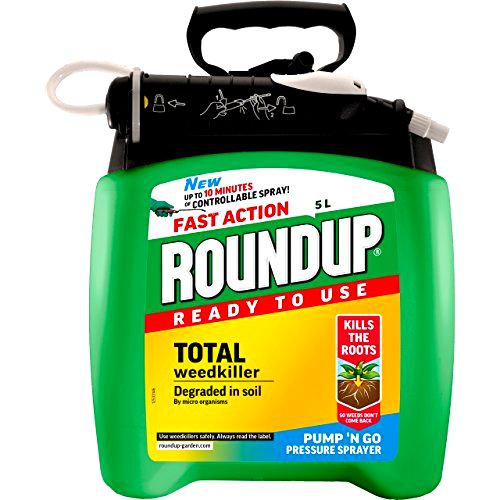
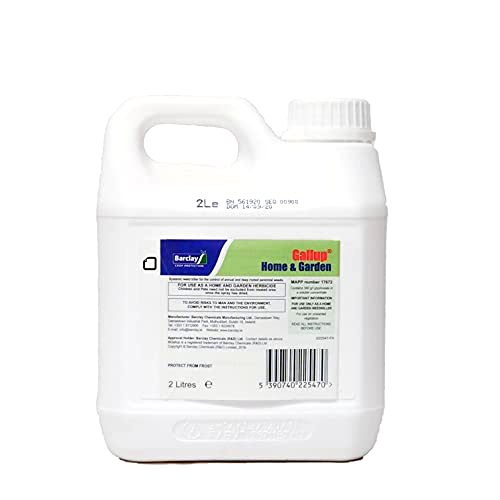

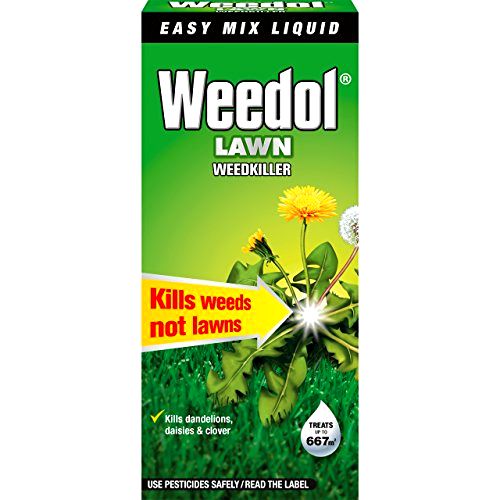
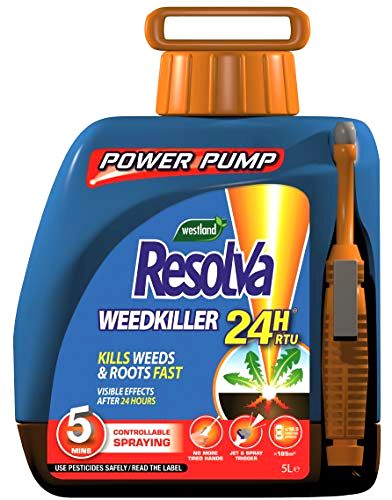
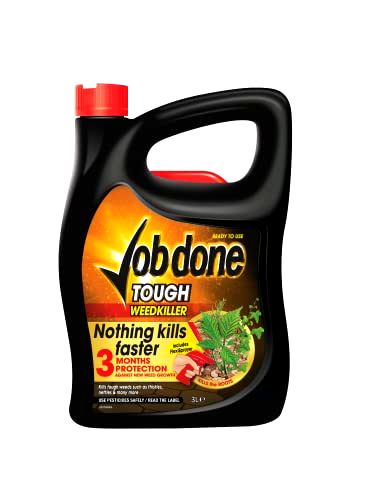
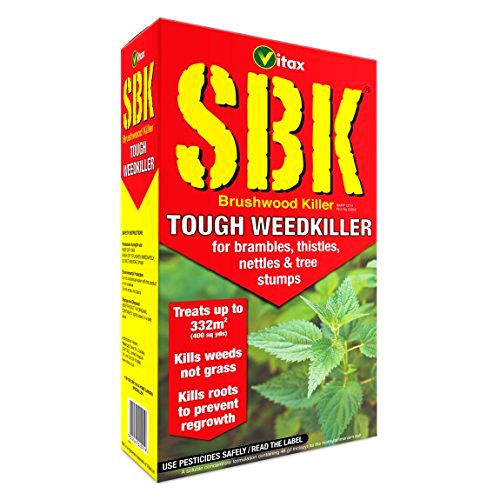
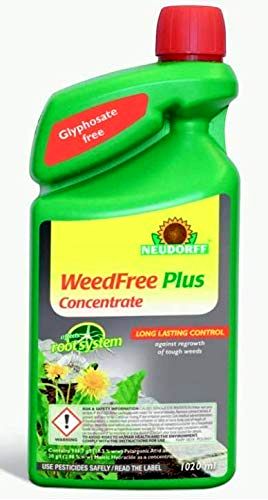
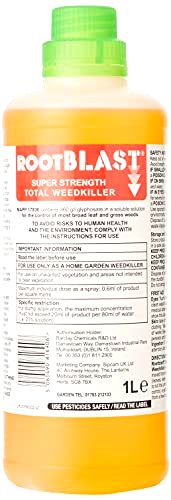
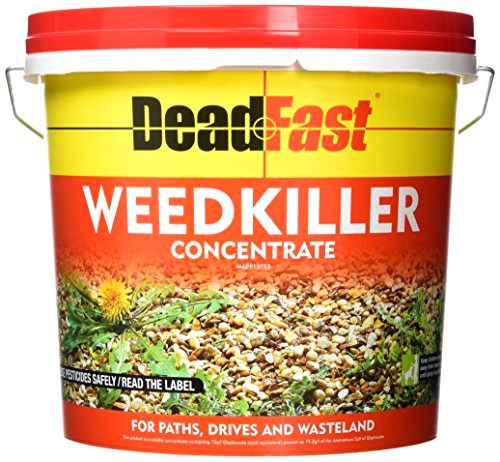
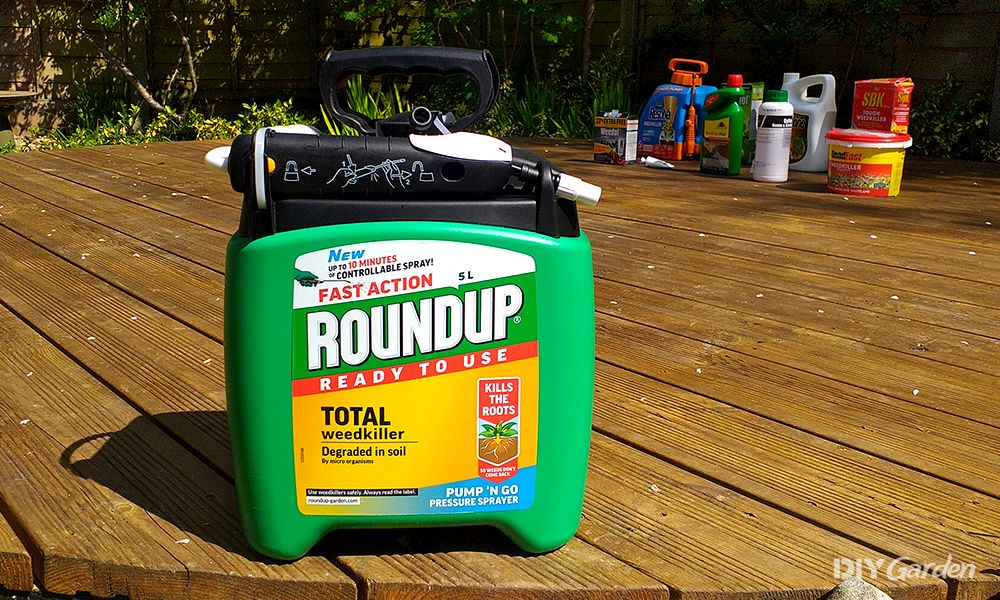
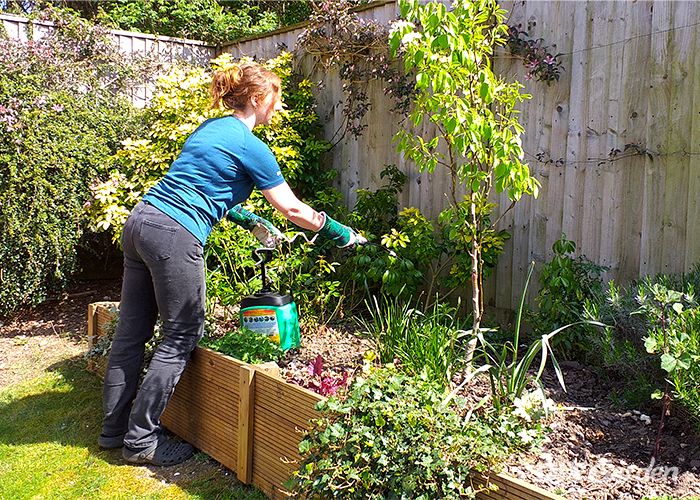
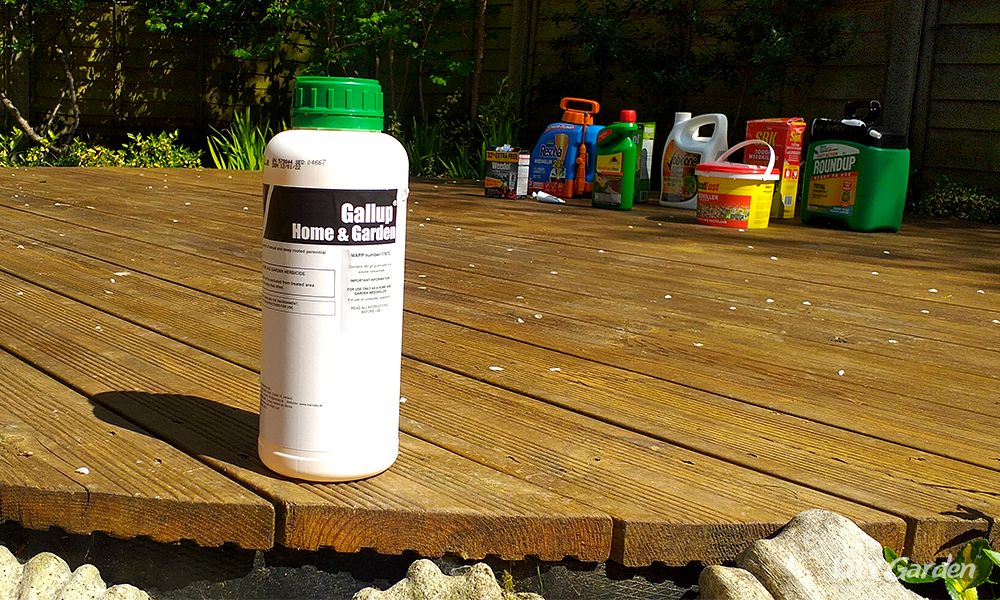
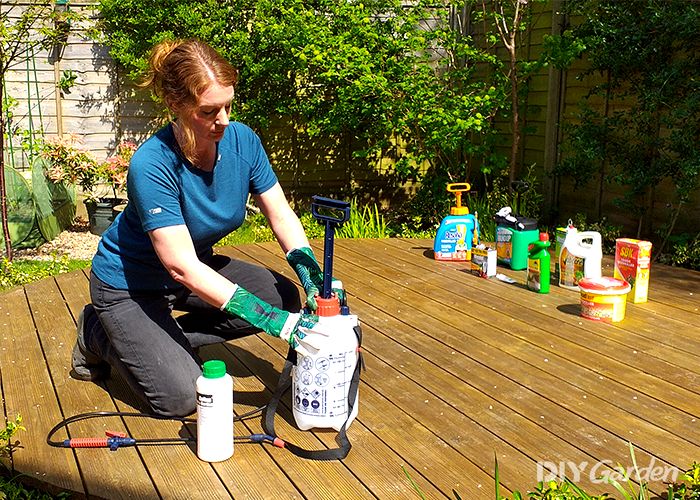
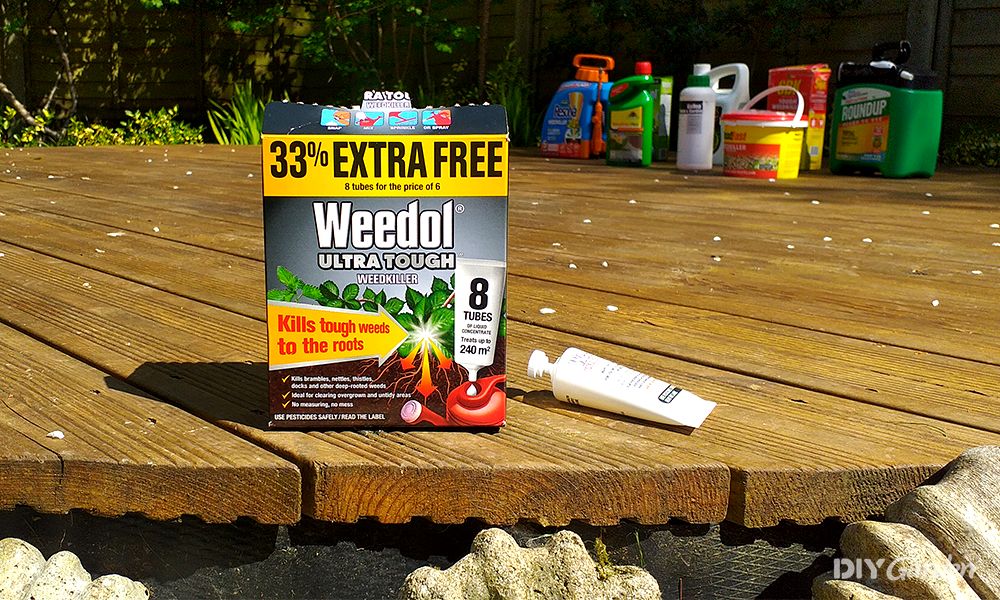
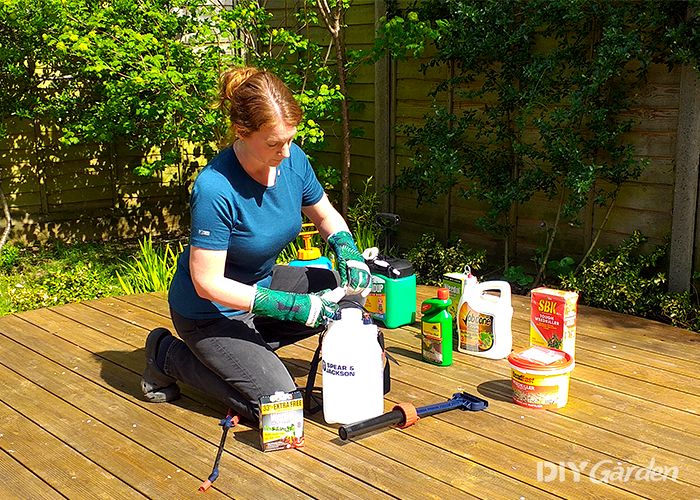
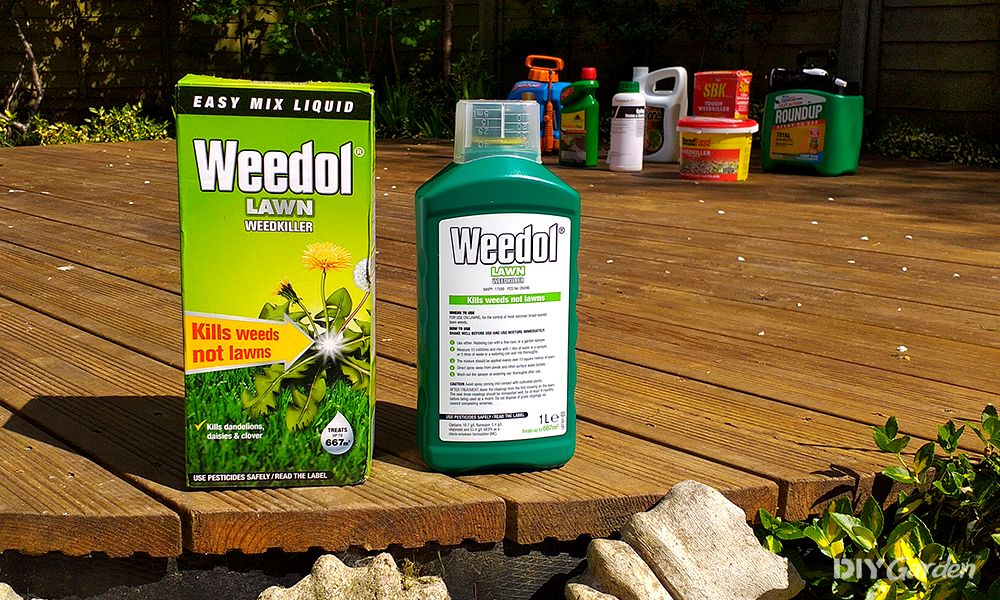
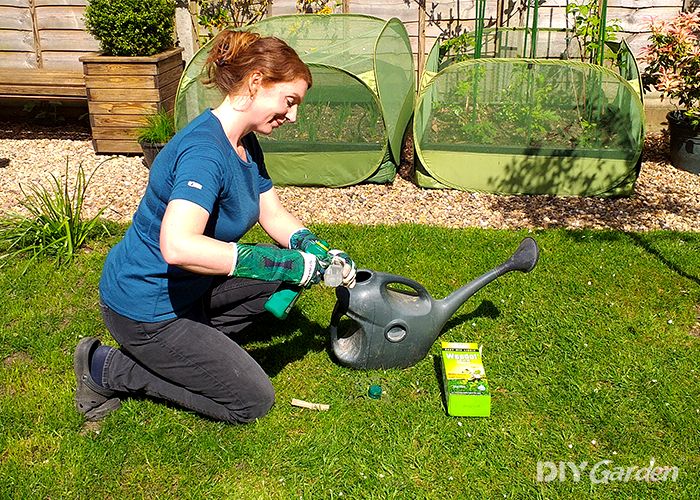
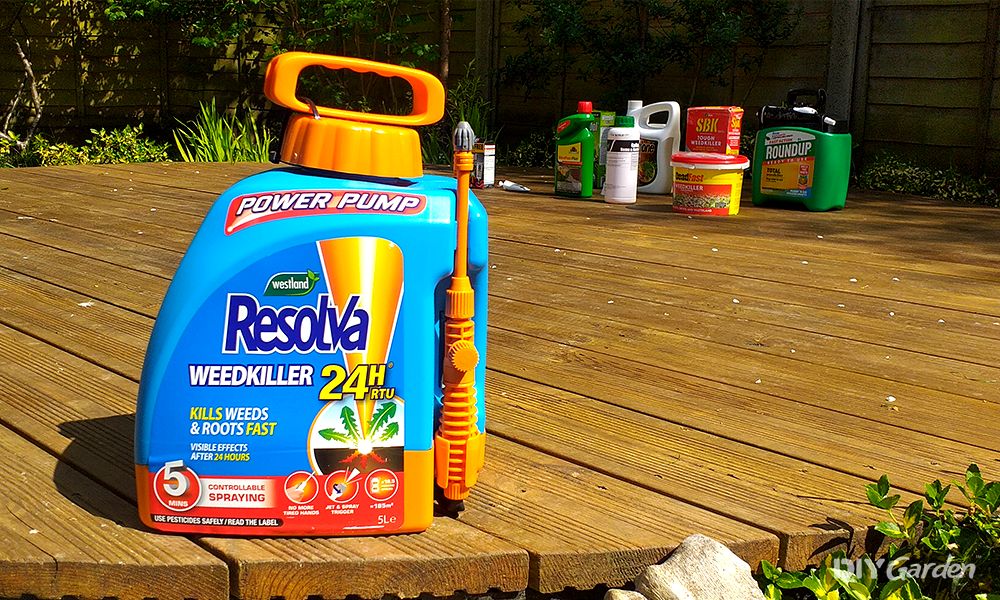
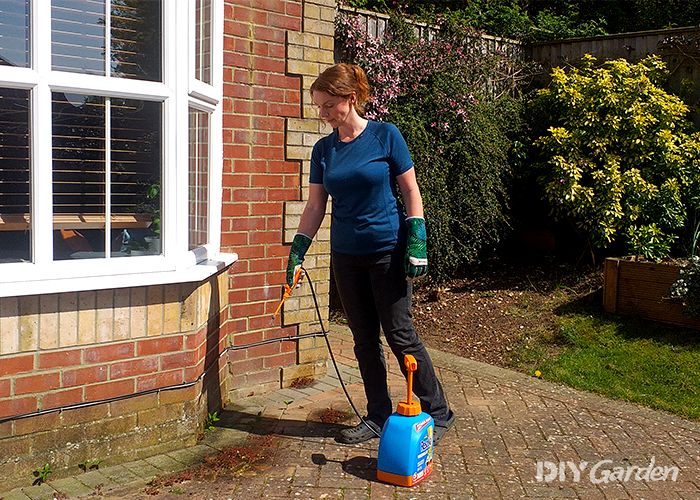
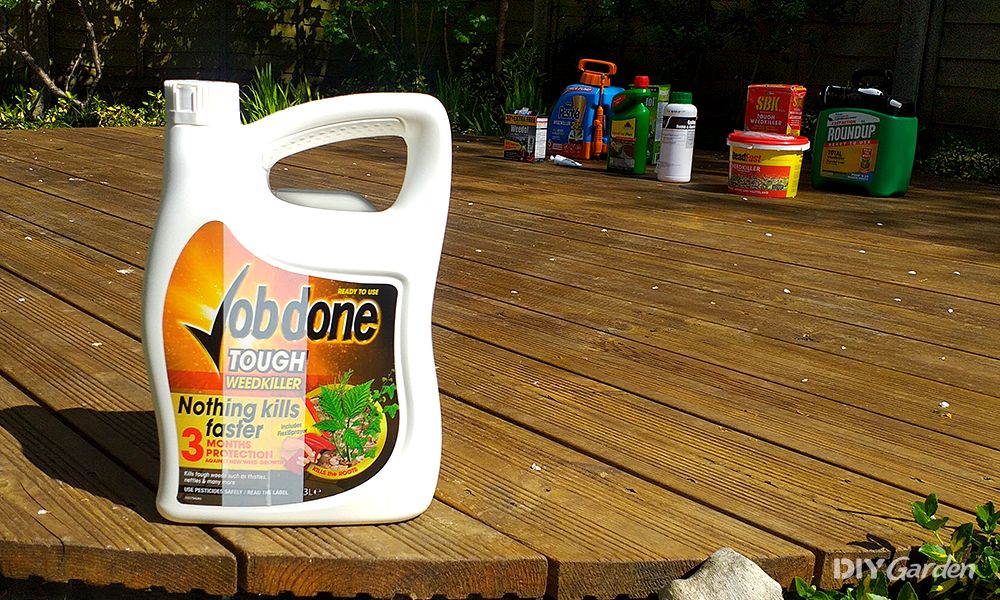
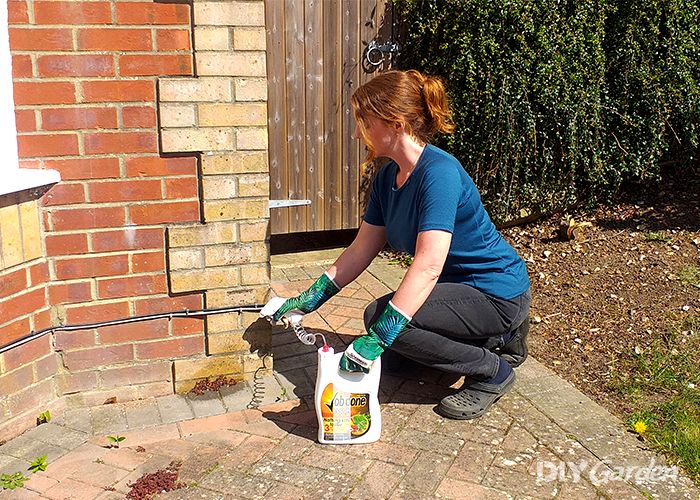
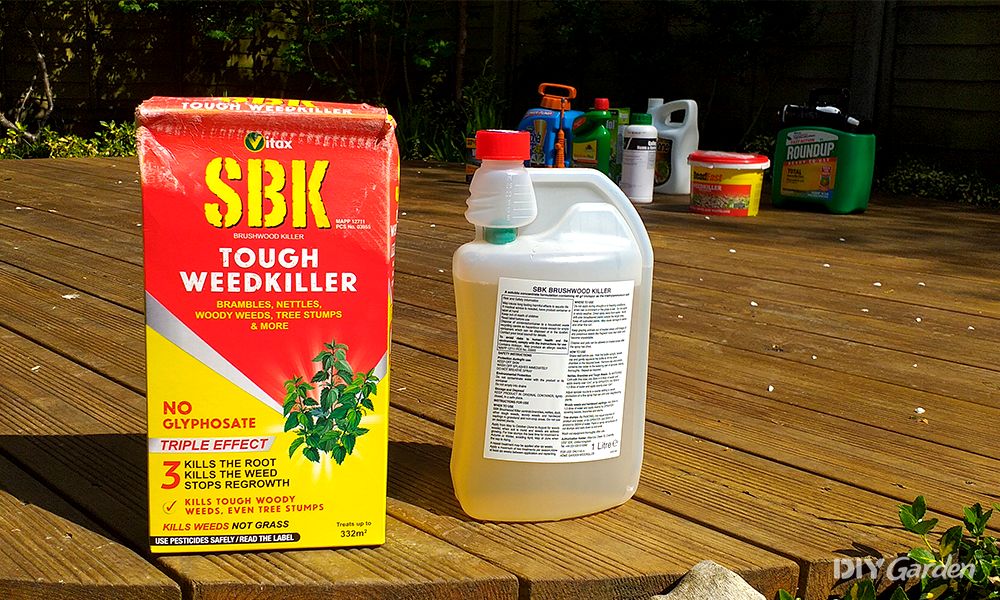
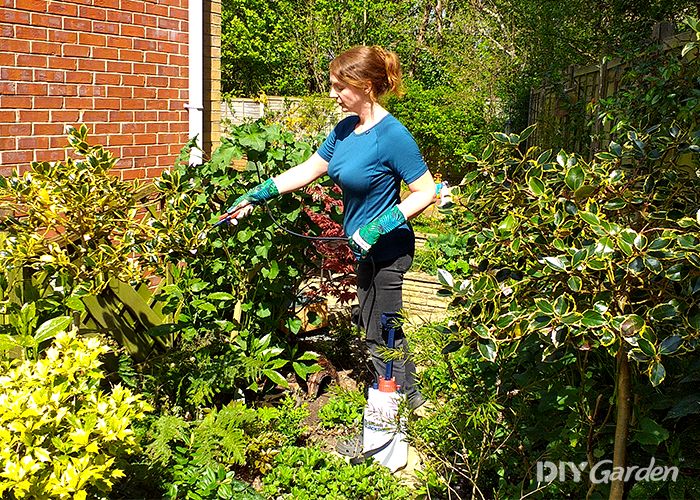
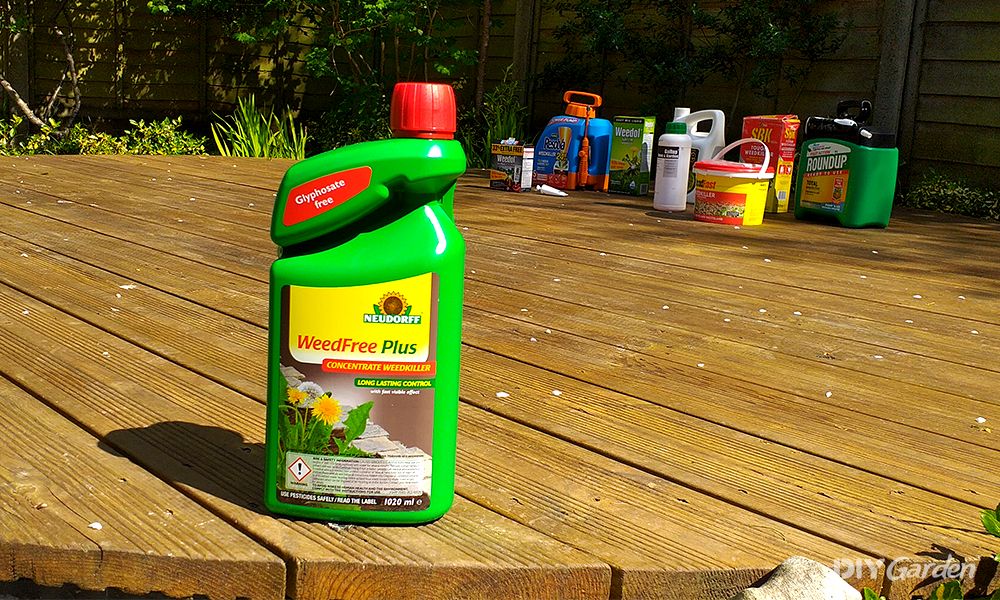
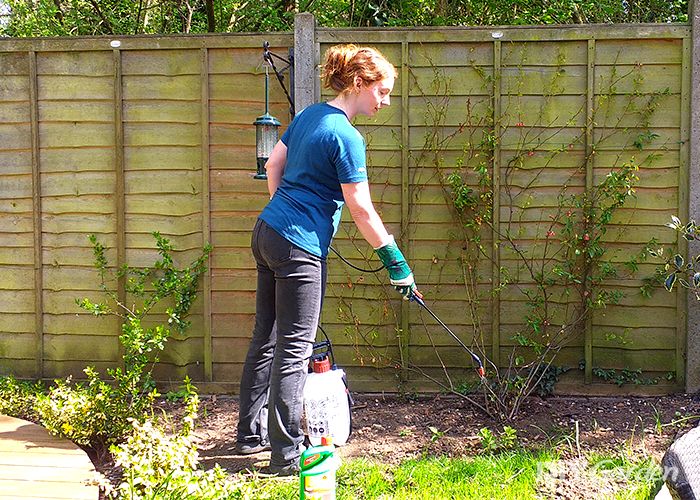
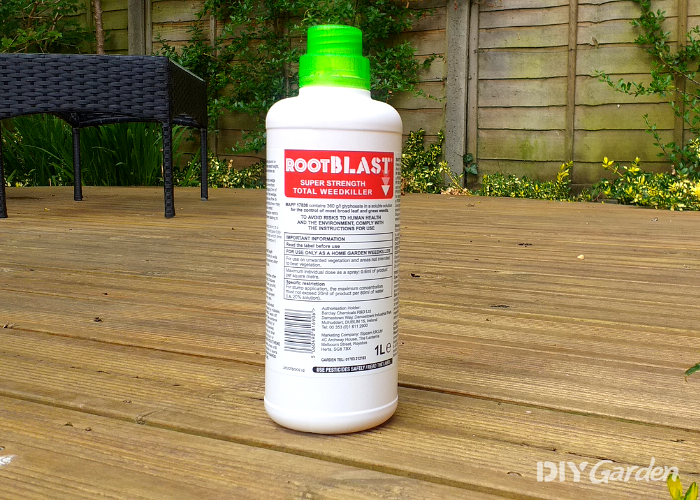
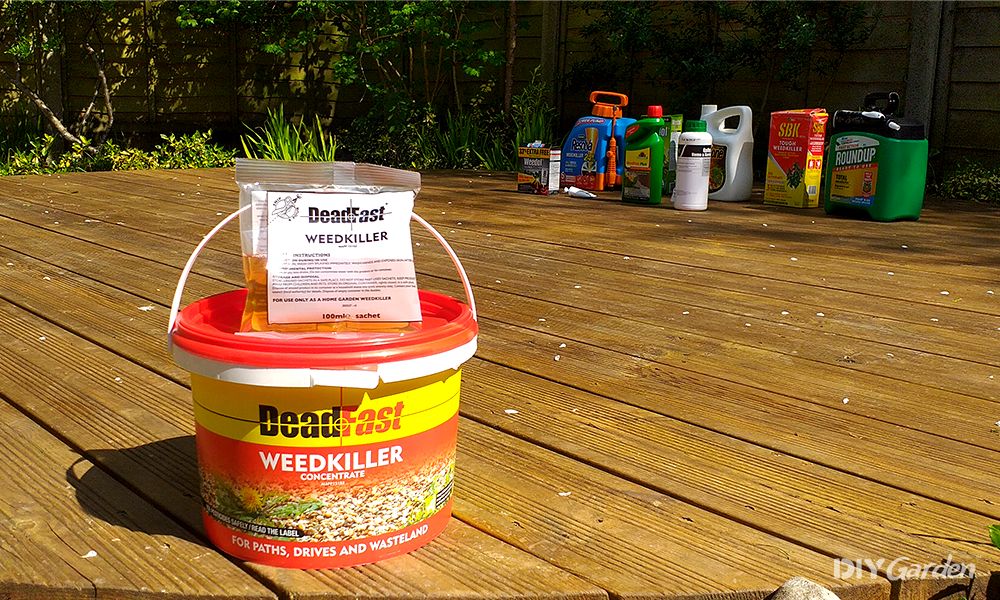
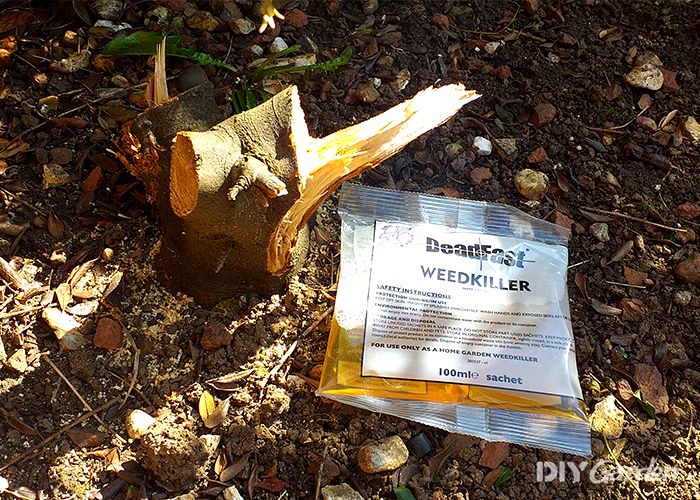

Share